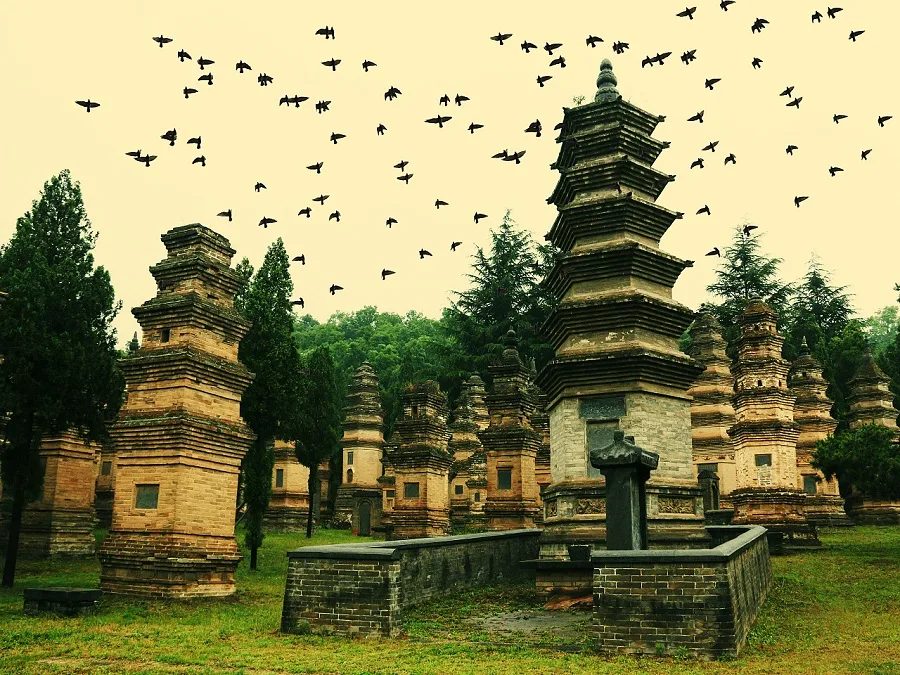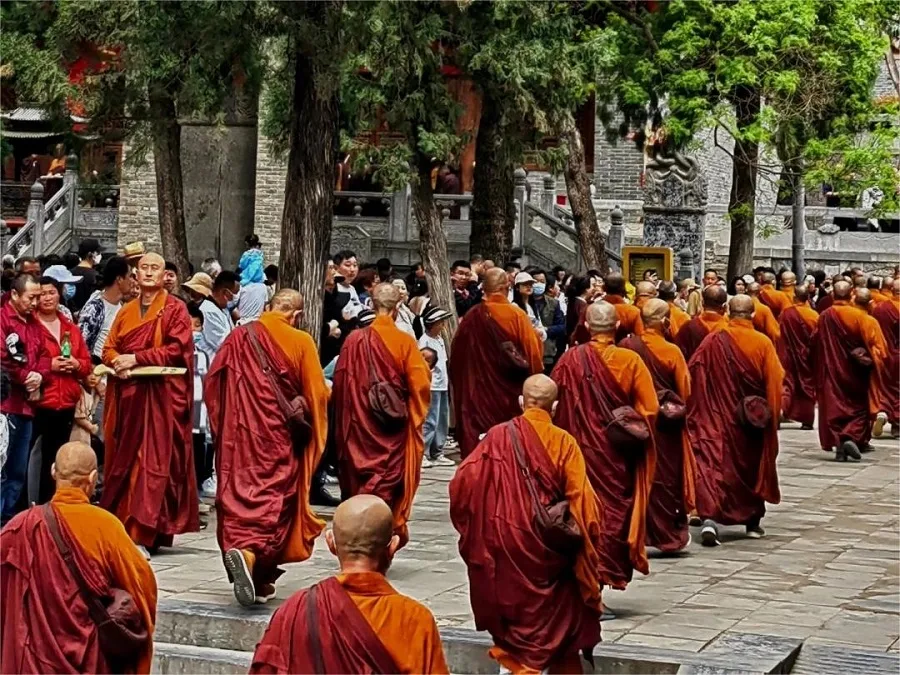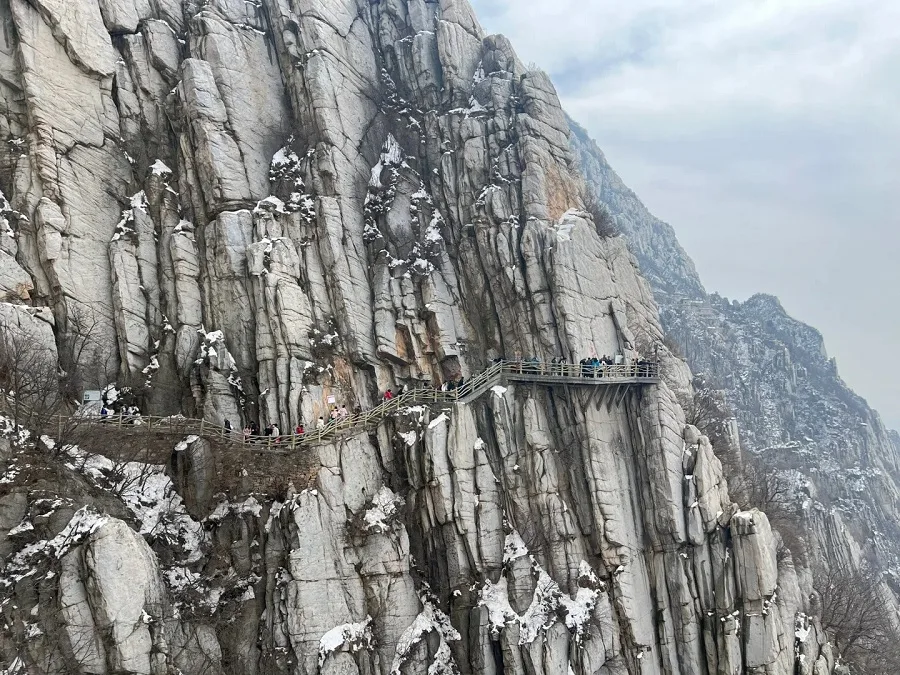Shaoshi Mountain (少室山), also known as “Jishi Mountain,” holds a rich historical and mythological significance. Legend has it that the sister of Tushan, one of the wives of Yu the Great from ancient Chinese mythology, resided on this mountain. In reverence to her, a temple called Shaoyi Temple was built at the foot of the mountain, hence the name “Shaoshi,” meaning “Younger Sister’s Residence.”
With its thirty-six peaks, Shaoshi Mountain presents a striking and steep landscape. When viewed from the north or south, the peaks seem to overlap each other like the unfolding petals of a lotus flower. This earned it the nickname “Shaoshi resembling a lotus” during the Tang Dynasty, and locals often refer to it as the “Nine-Peak Lotus Flower Mountain.”
The tallest peak, Liantian Peak, also known as Zhai Xing Tower (Picking Star Tower), rises to an elevation of 1512 meters. Beneath its northern slopes lies the renowned Shaolin Temple, famous for its martial arts tradition.
Climbing Shaoshi Mountain requires traversing narrow paths along sheer cliffs, using iron rings and steel wires for support. These ancient pathways, suspended along precipitous cliffs, evoke awe and admiration from visitors. Upon reaching the summit, one is greeted with panoramic views of verdant slopes, undulating forests, and ethereal clouds, creating an otherworldly experience reminiscent of a celestial realm.
Table of Contents
- Basic Information
- Location and Transportation
- Highlights of Shaoshi Mountain
- Vlog about Shaoshi Mountain
Basic Information
| Estimated Length of Tour | 1 day |
| Ticket Price | 80 RMB included in the ticket for Shaolin Temple |
| Opening Hours | 8.00 – 17.00 |
| Telephone Number | 0086-0371-62745000 |
Location and Transportation
Shaoshi Mountain is located to the west of Dengfeng City in Zhengzhou, Henan Province, China. It stands adjacent to the renowned Mount Song, with Taishi Mountain to its east, approximately 10 kilometers away. To reach Shaoshi Mountain, travelers can take advantage of several transportation options:
- From Zhengzhou: Depart from Zhengzhou Bus Passenger Transport Center (located at No. 14 Xinglong Street, Zhengzhou Railway Station Square) where buses to Shaolin Temple run daily between 6:30 AM and 11:40 AM. These buses provide direct access to the Shaoshi Mountain scenic area.
- From Luoyang: Depart from Luoyang Long-Distance Bus Station (opposite Luoyang Railway Station) and board buses bound for Dengfeng or Xuchang, with frequent departures throughout the day. The journey takes approximately 1.5 hours and will drop you off at the entrance to Shaolin Temple.
Highlights of Shaoshi Mountain
Shaolin Temple

Nestled beneath the Wuru Peak of Mount Song, Shaolin Temple boasts a rich history dating back to the Northern and Southern Dynasties. According to legend, Bodhidharma, a monk from India, arrived in China during this period and was honored by Emperor Xiaowen of the Northern Wei Dynasty for his mastery of Chan Buddhism. In 496 AD, Emperor Xiaowen ordered the construction of a temple at Shaoshi Mountain to provide sustenance for Bodhidharma. Shaolin Temple, hidden deep within the forests of Shaoshi Mountain, gained its name from this location, meaning “Temple Hidden Deep in the Forest of Shaoshi Mountain.” The temple complex, including the meditation halls and pagoda forest, has been recognized as a UNESCO World Heritage Site as part of the Historic Monuments of Dengfeng.
Shaoshi Temple

Formerly known as Honghua Temple, Shaoshi Temple is a sacred Buddhist site dedicated to spreading the teachings of Buddhism and enlightening sentient beings. As one of the seventy-two temples on Mount Song, it derives its name from its location at the southern foothills of Shaoshi Mountain. Originally built during the early Tang Dynasty, the temple was destroyed during the late Qing Dynasty. Though little remains of the original structures due to the tumultuous history, efforts to restore Shaoshi Temple began in 2014 following a local government decision prompted by requests from Buddhist devotees in accordance with national religious policies.
Shaolin Yonghua Hall

Originally situated on the southern bank of the Shaoxi River, opposite the main Shaolin Temple complex, Shaolin Yonghua Hall was known as the “Southern Courtyard of Shaolin” due to its proximity. Sadly, the original structures were destroyed by warlord Shi Yousan in 1928. However, disciples of Shaolin, following the reform and opening-up policies, raised funds to rebuild Yonghua Hall on the southwest of Maitreya Peak, southeast of Guanyin Peak, and northeast of Dizang Peak on the sunny side of Shaoshi Mountain.
Shaoshi Qingxue (Clear Snow)

A unique natural phenomenon, Shaoshi Qingxue is a flat stone resembling a table. After summer rains followed by clear skies, water flows down the mountain, and when sunlight hits the stone, it appears silver-white, glistening and radiant. From the platform in front of the abbot’s room at Shaolin Temple, visitors can witness this stunning sight. With clouds floating in the azure sky and sunlight illuminating the mountains, the scene resembles a snowy landscape in the midst of winter. This breathtaking view earned it the name “Shaoshi Qingxue” or “Clear Snow of Shaoshi.”
Sanhuangzhai (Three Emperors’ Fortress)

Sanhuangzhai is an integral part of Mount Song, designated as a UNESCO World Geopark and a national forest park. Located on the western foothills of Shaoshi Mountain in Dengfeng City, it boasts an elevation of 1512 meters, making it the tallest peak in the Song Mountain range. The area covers approximately 35 square kilometers and is renowned for its stunning natural scenery and rich cultural heritage. Visitors can explore its unique geological formations and diverse landscapes, making it a popular destination for sightseeing and exploration.

